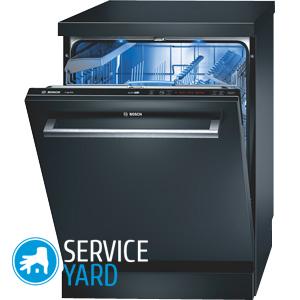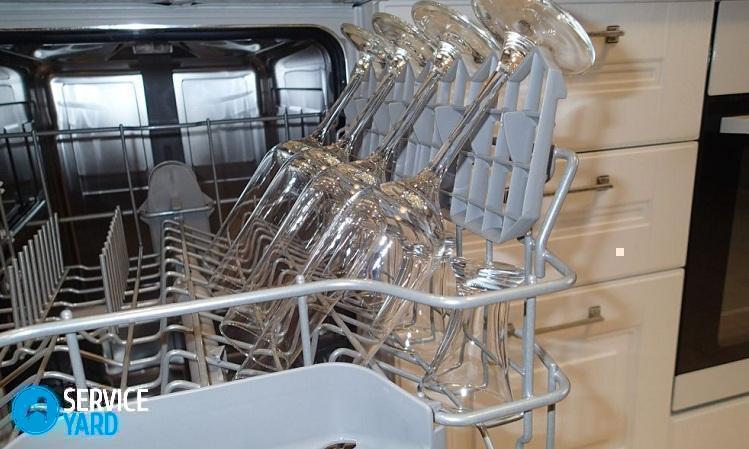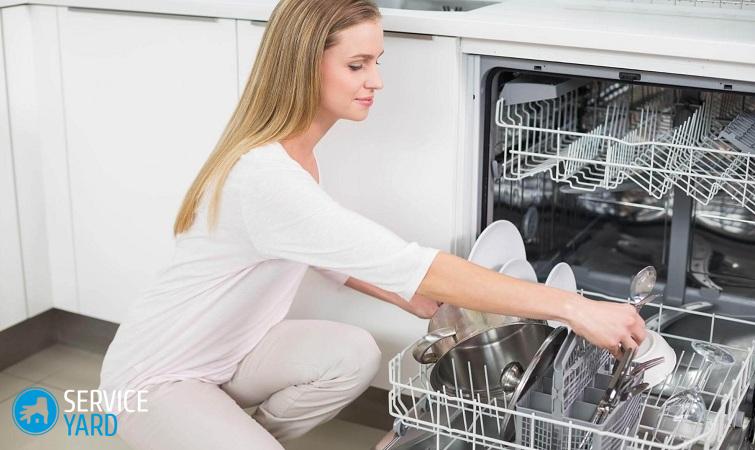How to place the dishes in the dishwasher?

Proper loading of dirty dishes in the dishwasher is one of the main conditions for quality washing. At first, loading may take at least twenty minutes of your time to carefully and carefully arrange all the items. But getting used and getting used to it, you will do it much faster. In this article you will find recommendations on the use of such a device and learn how to properly arrange the dishes in the dishwasher.
to contents ↑Dishwasher Facts
The very first mechanized sink for kitchen utensils went on sale in 1886. In the 1950s, compact dishwashers for home use went on sale in the United States. In our country, such an apparatus has long been considered a real luxury, but in recent years, more and more women have realized their advantages: saving time, washing quality.
This is also used by manufacturers of household appliances, which offer a fairly wide range of models. And consumers are increasingly asking one question to sellers: how to put dishes in the dishwasher and how to use this wonderful technique in general. But it’s difficult to remember all the rules right away, so at the beginning after the acquisition it’s better to keep a “cheat sheet” on hand.
Types of Dishwashers
Modern dishwashers are:
- Floor standing (stand-alone or built-in).
- Desktop (compact).
Floor dishwashers, in turn, are of two types:
- Narrow - about 9-13 sets (width 45 cm).
- Full-format - about 7-16 sets (width 60 cm).
Important! A set means a set of dishes for one person (deep plate, flat plate, mug, saucer, cutlery).
Also, dishwashing machines differ in the following characteristics:
- Mode of operation.
- Type of download.
- Efficiency of electricity and water consumption.
to contents ↑Important! Regardless of the brand of the dishwasher, it is imperative to know the general rules on how to properly place dishes in the dishwasher, to follow them all the time.
Cookware
Before you start arranging the dishes in the compartments of the apparatus, you should remove all the remnants of unfinished food. And the better this is done, the better the dishes will be washed, in addition, the risk that the drainage system of the machine will clog will be reduced.
Important! You can clean the dishes with a napkin, rubber spatula or sponge. Be careful not to leave bean grains, fruit seeds or corn.
Do I need to rinse the dishes before putting them in the dishwasher? - Of course, if you rinse the plates under running water, then they will be washed much better.
Then the counter question arises, why do I need a dishwasher if you still have to wet your hands? - If you are accustomed to accumulating dishes, then rinsing is indispensable, because dried food residues are washed quite poorly. But if you wash the dishes immediately after eating, then you can not bother and put it in trays without rinsing.
to contents ↑Placement of glasses, cups, mugs
Now I would like to deal with different dishes and how to put the dishes in the dishwasher one by one. Let's start with mugs, cups and glasses.
Important! In most devices, the upper tray is designed for them. Cups, mugs and glasses must be placed upside down so that the water can also wash the inside and then drain down. The horizontal arrangement of these objects is unacceptable, because water will not be able to fully get inside.
Glasses and wine glasses are also fixed with the foot up in a holder specially designed for this purpose. Glasses should not touch each other so that fragile glass is not damaged during washing. A plastic holder can also be used to hold small coffee and tea cups.
to contents ↑Placement of different plates
Depending on the purpose and shape of the plates, they can be placed on both the upper and lower trays. If the volume of the device allows, on the upper tray you can place:
- Dessert Plates.
- Salt shakers.
- Gravy boats.
- Bowls.
- Saucer.
- Kremanka.
- Bowls.
- Small braids.
If necessary and the condition of heating the water to low temperatures on the upper shelf, you can also place plastic dishes, but away from the heating element so that the plastic does not deform.
On the lower tray, it is customary to place the dishes in a medium and large diameter dishwasher, soup plates. In this case, large plates are best placed at the edges, and small ones in the center. This provides better access to water in the upper tray. In addition, the plates can be set facing the center of the unit so that they do not touch each other.
Important! The greater the clearance between the plates, the better they are washed, so if the size of the device allows, then place the plates less often.
Too overload a small dishwasher makes no sense, because the dishes will remain dirty, and you will be disappointed in the technique.
to contents ↑Placement of cutlery
For cutlery, which includes spoons, forks and serving knives, a special basket is provided in the dishwasher. It is necessary to place the forks and spoons freely, it is better to alternate between them - this will be correct.
Important! If you fold the spoons to each other tightly, then they will not be washed qualitatively. Knives are placed blade down.
In newer models of dishwashing machines, such as the Bosch brand, cutlery includes the topmost tray. In this tray, the spoons are horizontal. This provides not only a good dishwashing, but also an economical distribution of the space inside the dishwasher. In addition, the horizontal arrangement of knives, forks and spoons is much safer.
to contents ↑Important! Ceramic and sharp knives in the dishwasher should not be washed, because the blade can become dull. Also, you cannot wash knives with a handle made of wood - from prolonged exposure to water, the tree may swell.
Placement of pots and pans
If everything is more or less clear with small dishes, then how to put pots in a dishwasher is not an easy question:
- Pans, pots, stewpan, baking trays - all this must be placed in the lower container.
- It is best to wash these dishes separately from dishes made of crystal, porcelain, glass, choosing for this a more intensive mode and with a high temperature.
- Pans, pans should be placed sideways, and pots - at an angle or upside down. This is the only way to ensure maximum water access to all placed dishes in the dishwasher. If you put baking sheets or pans upside down, they will block access to the upper tray, and the dishes that are there will remain dirty.
- If the handle is removed from the pan, then be sure to remove it. Place the pan with the handle so that it does not touch the walls of the apparatus.
to contents ↑Important! Teflon-coated dishes must not be washed in the dishwasher by their manufacturer, so be careful.
Is it possible to wash kitchen utensils in the dishwasher?
Kitchen utensils mean shovels, skimmers, ladles, cutting boards - all this can be washed in a dishwasher, provided that these items are not made of wood and preferably not of plastic.
Plastic blades can be placed on the top tray for utensils, cutting boards in the side compartments of the upper or lower tray, depending on the size of the board. But nevertheless, it is better to wash boards with hands.
to contents ↑Important! Shovels and ladles should be located exclusively horizontally. Even if there is no specially designed compartment for them, there is enough space in the upper compartment for them.
Dishwasher loading tips
Knowing some rules on how to place dishes in a dishwasher, it is not difficult to do this. But many have the question: how many dishes can be washed in one cycle?
As a rule, the manufacturer indicates the capacity of the device in the number of sets. Small machines accommodate up to 6 sets, narrow ones up to 11, and full-length ones up to 17 sets of dishes.
However, the sets are not in quantity, but in the size of the dishes may be different. In addition, someone can only use plates for salad and soup and not use saucers at all.
We suggest paying attention to some more rules for placing dishes in a dishwashing machine:
- It is not recommended to load the dishwasher to the maximum - a large clearance between objects will make it possible to better wash the dishes.
- Before putting any object into the apparatus, you should make sure that it can be washed in it, especially for plastic products, fragile wine glasses made of crystal and glass.
- Place dishes so that they do not touch each other.
- If possible, wash pots and pans separately from plates, glasses and mugs.
- If you prefer to collect all the dishes throughout the day, it is better to immediately arrange the dirty dishes in the car - they will not dry out in it, so it will then be easier to wash off.
Means for washing
The usual means for manual washing - powders or gels, are not suitable for dishwashers. This is the same as in the case of washing machines, where the means for hand washing are not suitable for automatic machines (foam will fall from all holes).
When using soap, powders, other means for manual washing, you will have to look for a repair workshop very quickly. And even under the guarantee you will not be restored, because the instructions clearly state that it is necessary to use exclusively special detergents (Somat, Finish, Vortex, Sodasan, Astonish).
Types of detergents
On sale such funds are represented by the following classes:
- Detergents (tablets or powders).
- Salt.
- Rinse Aid.
Important! Modern devices for one wash consume approximately 30 g of regenerating salt and the same amount of powdered detergent. The average consumption in tablets is 1 tablet for every 20 liters of water.
Tablets are considered more practical. They are combined, single-layer and multi-layer. The first option combines detergent components, regenerating salt and rinse aid. If the model of your machine involves the use of tablets, then you do not need to buy 3 different substances.
Important! In gentle dishwasher programs, tablets are not recommended to be used, since the tablet does not have time to dissolve.
Special Tools Efficiency
By properties, special detergents can be divided into:
- Alkaline.
- Strongly alkaline.
Important! Detergents must be used in the quantity indicated on the package, since in this case more - does not mean better at all.
Additional funds
In addition to detergent, a good rinse aid is required for high-quality dishwashing. It eliminates the remnants of the soapy substance, and also gives shine.
Important! Rinse aid consumption is calculated approximately 0.5-0.7 liters for 10-12 cycles.
Special softeners
In addition to the foregoing, the cleanliness of the dishes still depends on the hardness of the water. If the water is too hard, then white stains may remain on the utensils. In order for the machine to function normally, there are regenerating salts. They help soften water and have a beneficial effect on washing efficiency.
to contents ↑Important! The capacity, which is designed for salt in the dishwasher, is large enough, designed for 1-2 kg. Due to the fact that lime from water often settles on the heating elements inside the machine, the use of salt is simply necessary to protect against scale and avoid breakage.
Stock footage
So, putting the dishes in the dishwasher is not so difficult. After several washing cycles, you will do this automatically. We hope our tips will help you, and miracle technology will please you for more than one year.
- How to choose a vacuum cleaner taking into account the characteristics of the house and coatings?
- What to look for when choosing a water delivery
- How to quickly create comfort at home - tips for housewives
- How to choose the perfect TV - useful tips
- What to look for when choosing blinds
- What should be running shoes?
- What useful things can you buy in a hardware store
- Iphone 11 pro max review
- Than iPhone is better than Android smartphones





